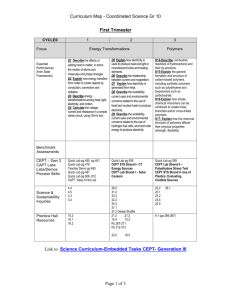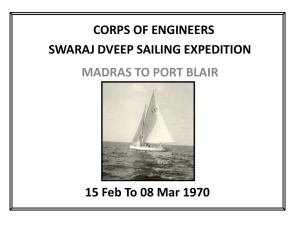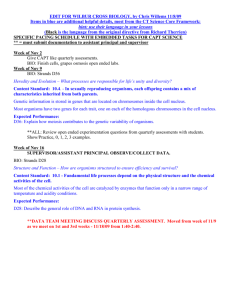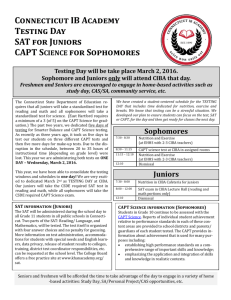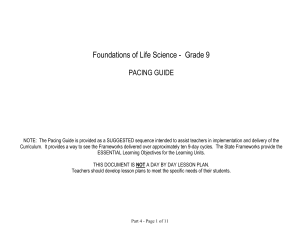9th Grade Science Curriculum Map
advertisement
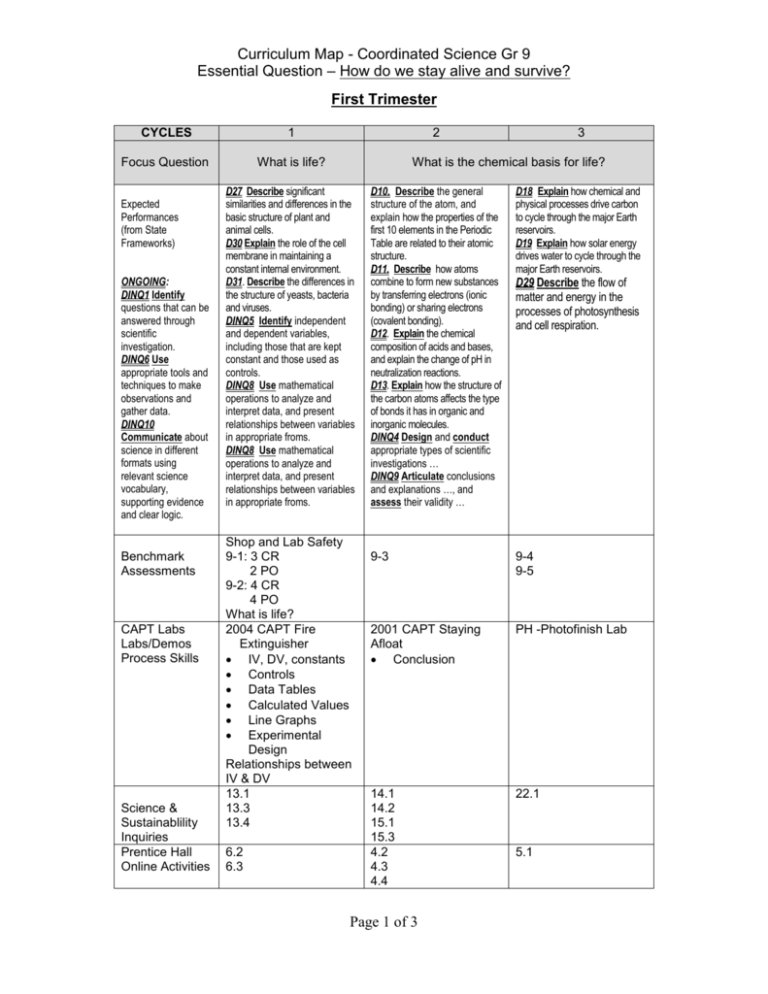
Curriculum Map - Coordinated Science Gr 9 Essential Question – How do we stay alive and survive? First Trimester CYCLES 1 Focus Question What is life? Expected Performances (from State Frameworks) ONGOING: DINQ1 Identify questions that can be answered through scientific investigation. DINQ6 Use appropriate tools and techniques to make observations and gather data. DINQ10 Communicate about science in different formats using relevant science vocabulary, supporting evidence and clear logic. Benchmark Assessments CAPT Labs Labs/Demos Process Skills Science & Sustainablility Inquiries Prentice Hall Online Activities 2 What is the chemical basis for life? D27 Describe significant similarities and differences in the basic structure of plant and animal cells. D30 Explain the role of the cell membrane in maintaining a constant internal environment. D31. Describe the differences in the structure of yeasts, bacteria and viruses. DINQ5 Identify independent and dependent variables, including those that are kept constant and those used as controls. DINQ8 Use mathematical operations to analyze and interpret data, and present relationships between variables in appropriate froms. DINQ8 Use mathematical operations to analyze and interpret data, and present relationships between variables in appropriate froms. Shop and Lab Safety 9-1: 3 CR 2 PO 9-2: 4 CR 4 PO What is life? 2004 CAPT Fire Extinguisher IV, DV, constants Controls Data Tables Calculated Values Line Graphs Experimental Design Relationships between IV & DV 13.1 13.3 13.4 6.2 6.3 3 D10. Describe the general structure of the atom, and explain how the properties of the first 10 elements in the Periodic Table are related to their atomic structure. D11. Describe how atoms combine to form new substances by transferring electrons (ionic bonding) or sharing electrons (covalent bonding). D12. Explain the chemical composition of acids and bases, and explain the change of pH in neutralization reactions. D13. Explain how the structure of the carbon atoms affects the type of bonds it has in organic and inorganic molecules. DINQ4 Design and conduct appropriate types of scientific investigations … DINQ9 Articulate conclusions and explanations …, and assess their validity … D18 Explain how chemical and physical processes drive carbon to cycle through the major Earth reservoirs. D19 Explain how solar energy drives water to cycle through the major Earth reservoirs. 9-3 9-4 9-5 2001 CAPT Staying Afloat Conclusion PH -Photofinish Lab 14.1 14.2 15.1 15.3 4.2 4.3 4.4 22.1 Page 1 of 3 D29 Describe the flow of matter and energy in the processes of photosynthesis and cell respiration. 5.1 Curriculum Map - Coordinated Science Gr 9 Essential Question – How do we stay alive and survive? Second Trimester CYCLES 4 5 What makes an organism unique? Focus Question Expected Performances (from State Frameworks) ONGOING: DINQ1 Identify questions that can be answered through scientific investigation. DINQ6 Use appropriate tools and techniques to make observations and gather data. DINQ10 Communicate about science in different formats using relevant science vocabulary, supporting evidence and clear logic. D28 Describe the general role of DNA in protein synthesis cell reproduction. D34. Describe, in general terms, how the genetic information of organisms can be changed to make them produce new materials. D35. Explain the risks and benefits of altering the genetic composition and cell products of existing organisms D 33. Explain how bacteria and yeasts are used to produce for human consumption. D36. Explain the usefulness of meiosis in maintaining organisms' genetic variations. D37. Use the Punnett Square technique to predict the distribution of traits in mono- and di-hybrid crossings. D38. Deduce the probable mode of inheritance of traits (e.g., recessive/ dominant, sex-linked) from pedigree diagrams showing phenotypes. Debate w/ Rubric Benchmark Assessments 9-6 CAPT Labs Labs/Demos Process Skills CEPT Lab-Strand IV– Apple Juice 9-8 SS 18.2 Performance 7 How do living things change? D40. Explain how the processes of genetic mutations and natural selection are related to the evolution of the species. D41. Explain how the current theory of evolution provides a scientific explanation to fossil records of ancient life forms. CAPT LAB CEPT STS – Strand IV GMO (Genetically Modified Organisms) CAPT “Tiny Bubbles” Task 17.2 17.3 17.4 18.1 18.2 9.5 9.6 10.2 10.3 Science & Sustainablility Inquiries Prentice Hall Online Activities 6 How does an organism pass on its traits? 19.1 19.2 18.3 19.3 18.4 20.1 11.6 14.2 Link to Science Curriculum-Embedded Tasks CEPT- Generation III Page 2 of 3 Curriculum Map - Coordinated Science Gr 9 Essential Question – How do we stay alive and survive? Third Trimester CYCLES 8 9 10 Focus Question What attacks life and negatively impacts it? How do living things change? What interactions affect populations? Expected Performances (from State Frameworks) ONGOING: DINQ1 Identify questions that can be answered through scientific investigation. DINQ6 Use appropriate tools and techniques to make observations and gather data. DINQ10 Communicate about science in different formats using relevant science vocabulary, supporting evidence and clear logic. Benchmark Assessments D39. Describe the difference between genetic disorders and infectious diseases. D32. Describe how bacterial and viral infectious diseases are transmitted and explain the role of sanitation, vaccination and antibacterial medications in the prevention and treatment of infectious diseases. D42. Describe how structural D 43. D44. Explain how change in and behavioral adaptations population density is affected increase organisms' survival by emigration, immigration, in their environment birth rate and death rate, and relate it to the exponential D43 Describe the factors that growth of human populations. affect the carrying capacity of D45 Explain how the environment. technological advances affected the size and growth rate of human populations through history. Karyotype 9-14 Interdisciplinary Task CEPT Lab Strand V Populations CAPT Labs Labs/Demos Process Skills Science & Sustainablility Inquiries Prentice Hall Online Activities 12.2 31.1 31.4 14.3 CEPT STS Strand VCompare Underdeveloped with Developed Countries 7.3 8.3 9.1 8.1 7.4 35.3 Link to Science Curriculum-Embedded Tasks CEPT- Generation III Page 3 of 3
